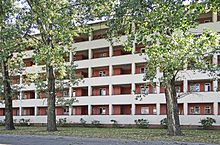Ludmilla Herzenstein
Ludmilla Herzenstein (born April 6, 1906 in St. Petersburg , † August 4, 1994 in Berlin ) was a German architect, urban planner and children's book author of Russian origin.
Life
Ludmilla Herzenstein spent childhood and youth in Berlin and began studying architecture at the TH Berlin-Charlottenburg in 1926. From 1929 to 1930 she worked as a student trainee with the architect and former St. Petersburg building officer Alexander Klein and with the “Allgemeine Häuserbau AG Berlin”, where she took over the construction management of the Onkel Toms Hütte housing estate in Berlin-Zehlendorf , which Bruno Taut had designed . In 1933 she completed her diploma under Heinrich Tessenow . From 1935 to 1945 she worked in various planning and architecture offices in Berlin, Rostock, Hamburg, Königsberg, Wiesbaden and Konitz / West Prussia and was entrusted with a wide range of activities. In 1937 she was accepted into the Reich Chamber of Culture .
After the end of the Second World War , in December 1945, she wrote the children's book “The Curious Duckling” as a “Christmas present for the Berlin children” on behalf of the Soviet military administration, which was only distributed as a hectograph due to a lack of paper . It was first published in 1952 with illustrations by Ingeborg Meyer-Rey and has since been published in many editions and several translations. In the same year, 1945, Ludmilla Herzenstein became a consultant for "research statistics" in the planning office of the Berlin magistrate and employee in Hans Scharoun's planning collective for the development of a development plan (collective plan ) for Berlin, which was badly damaged during the war. In cooperation with Hans Scharoun, she designed the "Friedrichshain living cell" and two modern arcade houses in it .
After the division of Berlin in 1949, Ludmilla Herzenstein took over the management of the “Heimstätte Berlin” in East Berlin and was responsible for the execution of the arcade houses. Until 1958 she was in charge of the department for housing planning in the main office for urban planning in East Berlin. She then became head of the urban planning department in the Berlin district of Weißensee , where she was responsible for the redevelopment of old building areas. From 1964 until her retirement in 1971 she was a district architect in Berlin-Weißensee; she designed u. a. 1966 the "Parkgaststätte Milchhäuschen" in the park on the White Lake .
Works
- 1949–50 two arcade houses (with Hans Scharoun), Karl-Marx-Allee 102/104 and 126/128, Berlin-Friedrichshain
- 1966–68 Park restaurant Milchhäuschen, Parkstrasse 33a, Berlin-Weißensee
Fonts
- 1948 Population development as a factor in town planning. In: Building planning and construction technology, booklet 7
- 1948 Population development as the basis for urban planning. In: Neue Bauwelt issue 19
- 1949 For discussion about the Berlin development plan. In: Neues Deutschland from July 20, 1949
- 1959 Popularization of town planning. (Series of articles) In: Weißenseer Nachrichten
- 1960 Some things from urban planning practice. In: German Architecture Issue 11
- 1963 Complex repairs in the Berlin-Weißensee district. In: Architecture of the GDR Issue 8
Awards
- 1962 Schinkel badge of the Association of Architects of the GDR (BdA)
- 1962 Bronze badge of honor from the Democratic Women's Association of Germany
- 1963 Badge of Honor of the National Front
- 1965 Medal of Merit of the GDR
literature
- Johann Friedrich Geist , Klaus Kürvers : The Berlin tenement house 1945-1989. Prestel-Verlag, Munich 1989, ISBN 3-7913-0719-3
- Kerstin Dörhöfer: pioneers in architecture. A building history of the modern age. Wasmuth Verlag, Tübingen 2004, ISBN 3-8030-0639-2
Web links
- * Tanja Scheffler: BAUWELT - The Great Unknowns - Architects of the GDR. In: bauwelt.de. November 1, 2017, accessed January 1, 2020 .
| personal data | |
|---|---|
| SURNAME | Herzstein, Ludmilla |
| BRIEF DESCRIPTION | German architect, urban planner and children's book author of Russian origin |
| DATE OF BIRTH | April 6, 1906 |
| PLACE OF BIRTH | St. Petersburg |
| DATE OF DEATH | 4th August 1994 |
| Place of death | Berlin |

